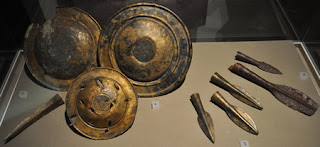Bronze Age is the earliest age of the Ancient Historic period which spans from 3300 BC to 1200 BC and that was characterized by the advancement of metal working, where it was discovered with the introduction of bronze, a hard alloy formed by smelting of copper along with the mixing of tin in it. Bronze itself is harder and more durable than other metals available at that time, allowing Bronze Age civilizations to gain a technological advantage. For some civilizations, the Bronze age marked the end of prehistory due to the development of writing methods.
Bronze Age refers to a period in human cultural development in which
they practiced intensive years round agriculture, developed a writing
system, invented the potter's wheel, created a centralized government, written law codes, city and nation states and empires,
embarked on advanced architectural projects, introduced social
stratification, economic and civil administration, slavery and also
have practiced organized warfare, medicine and religions and at last
they also laid foundations for astronomy, astrology and mathematics.
The
Bronze Age was a time of extensive use of metals and of developing
trade networks. Western Asia and the Near East was the first region
to enter the Bronze Age, which began in the mid of 4th
millennium BC with the rise of the
Mesopotamian civilization of Sumer which was often called as “The
Cradle Of Civilization”. Bronze age cultures differed in their
development of the first writing system. According to Archaeological
evidence, cultures in Mesopotamia and Egypt developed their own
earliest variable writing systems such as cuneiform scripts and
hieroglyphs respectively.
In
most areas of civilization, Bronze smelting became a foundation for
more advanced societies. For now, modern historians
have identified 5 prominent Bronze Age civilizations which had
emerged in that time period and they are :-
>> Sumer in the Fertile Crescent / Mesopotamia
>> Indus Valley in the Indo-Gangetic Plain
>> Erlitou in the North China Plain
>> Olmec in Mesoamerica
>> Norte Chico in the Andes / Greece.
By the end of the Bronze Age large states which are often called
empires, interacted with each other trough trade, warfare, migration
and the spread of ideas. The Bronze age ended abruptly around 1200
BC. Historians don't know for sure what caused the Bronze Age
collapse other than when human began to forge an even more stronger
metal called Iron but many believe that transition was sudden violent
and culturally disruptive.







Comments
Post a Comment